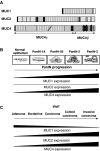Multiple roles of mucins in pancreatic cancer, a lethal and challenging malignancy
- PMID: 15494719
- PMCID: PMC2409950
- DOI: 10.1038/sj.bjc.6602163
Multiple roles of mucins in pancreatic cancer, a lethal and challenging malignancy
Abstract
Mucins are members of an expanding family of large multifunctional glycoproteins. Pancreatic mucins have important biological functions, including the protection, lubrication, and moisturisation of the surfaces of epithelial tissues lining ductal structures within the pancreas. Several lines of evidence support the notion that deregulated mucin production is a hallmark of inflammatory and neoplastic disorders of the pancreas. Herein, we discuss the factors that contribute to the lethality of pancreatic cancer as well as the key role played by mucins, particularly MUC1 and MUC4, in the development and progression of the disease. Aspects pertaining to the aberrant expression and glycosylation of mucins are discussed, with special emphasis on their potential impact on the design and implementation of adequate diagnostic and therapeutic strategies for combating this lethal malignancy.
Figures

References
-
- Adsay NV, Merati K, Andea A, Sarkar F, Hruban RH, Wilentz RE, Goggins M, Iocobuzio-Donahue C, Longnecker DS, Klimstra DS (2002) The dichotomy in the preinvasive neoplasia to invasive carcinoma sequence in the pancreas: differential expression of MUC1 and MUC2 supports the existence of two separate pathways of carcinogenesis. Mod Pathol 15: 1087–1095 - PubMed
-
- Andrianifahanana M, Moniaux N, Schmied BM, Ringel J, Friess H, Hollingsworth MA, Buchler MW, Aubert JP, Batra SK (2001) Mucin (MUC) gene expression in human pancreatic adenocarcinoma and chronic pancreatitis: a potential role of MUC4 as a tumor marker of diagnostic significance. Clin Cancer Res 7: 4033–4040 - PubMed
-
- Andrianifahanana M, Moniaux N, Batra SK (2004) Pathophysiological perspectives of pancreatic mucins. In Toxicology of the Pancreas – Biology, Pathophysiology, Etiology and Molecular Biology of Pancreatic Injury Pour P (ed) London, UK: Taylor & Francis, In press
-
- Balague C, Gambus G, Carrato C, Porchet N, Aubert JP, Kim YS, Real FX (1994) Altered expression of MUC2, MUC4, and MUC5 mucin genes in pancreas tissues and cancer cell lines. Gastroenterology 106: 1054–1061 - PubMed
-
- Braga VM, Pemberton LF, Duhig T, Gendler SJ (1992) Spatial and temporal expression of an epithelial mucin, Muc-1, during mouse development. Development 115: 427–437 - PubMed
Publication types
MeSH terms
Substances
Grants and funding
LinkOut - more resources
Full Text Sources
Other Literature Sources
Medical
Research Materials
Miscellaneous

